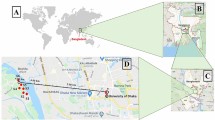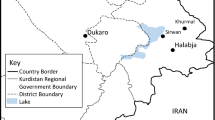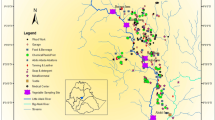Abstract
Anthropogenic activities have increased potentially toxic concentrations in our environments leading to rising health risk. This study was carried out in Salanta area of Kano State, Nigeria with the aim of exploring the impact of industries on the environment due to the release of potentially toxic element (PTE) in soils and water and its uptake by plants. These toxic elements [cadmium (Cd), chromium (Cr), lead (Pb) and zinc (Zn)] in soils, water and vegetables were analysed using atomic absorption spectrophotometry (AAS). The mean values of PTEs in 50 samples of soils and vegetables ranged from 0.50 to 7.50 mg/kg, 2.11 to 38.25 mg/kg, 0.001 to 3.13 mg/kg, 4.25 to 229.00 mg/kg and 0.25 to 10.50 mg/kg, 3.25 to 39.75 mg/kg, not detected (ND) to 0.023 mg/kg, 2.75 to 109.00 mg/kg for Cd, Cr, Pb and Zn, respectively, while in 18 surface water samples collected, it ranged from ND to 2.50 mg/L, ND to 3.50 mg/L and 0.50 to 10.50 mg/L for Cd, Cr and Zn, respectively, as Pb was not detected. Geo-accumulation index (Igeo) and transfer factor (TF) were determined. Geo (Igeo) values showed that soil (extremely contaminated, 10.6) and vegetables were contaminated with Cd but Cr, Pb and Zn levels were low (Igeo < 0). Transfer factors for onions and lettuce were above 1 for Cr and only lettuce was above 1 for Zn. The Target Hazard Quotient for vegetables sampled was above 1 for Cd. Target Hazard Quotient for water samples was also above 1 for Cd and Cr. Target Hazard Quotient values were higher in children than adults. Results show degrees of pollution as Cd and Cr concentrations were above the permissible limits.

Similar content being viewed by others
References
Ogunfowokan AO, Adekunle AS, Oyebode BA, Oyekunle JAO, Komolafe AO, Omoniyi-Esan GO (2019) Determination of heavy metals in urine of patients and tissue of Corpses by Atomic Absorption Spectroscopy. Chem Afr 2:699–712
Huang L, Rad S, Xu L, Gui L, Song X, Li Y, Wu Z, Chen Z (2020) Heavy metals distribution, sources and Ecological risk assessment in Huixian Wetland, South China. Water 12(431):1–14
Tchounwon PB, Yedjou CG, Patlolla AK, Sutton DJ (2012) Heavy metal toxicity and the environment. In: Luch A (ed) Molecular, clinical and environmental toxicology, experentia supplementum, vol 101. Springer, Basel, pp 133–164
Adei E, Forson-Adaboh K (2008) Toxic (Pb, Cd, Hg) and essential (Fe, Cu, Zn, Mn) metal content of liver tissue of some domestic and bush animals in Ghana. Food Addit Contam Part B Surveill 1(2):375–387
Kacholi DS, Sahu M (2018) Levels and health risk assessment of heavy metals in soil water and vegetables of Dar es Salaam Tanzania. J Chem Article ID 1402674:1–9. https://doi.org/10.1155/2018/1402674
Said I, Salmon SA, Samy Y, Awad SA, Melegy A, Hursthouse A (2019) Environmental factors controlling potentially toxic element behavior in urban soils, El Tebbin, Egypt. Environ Monit Assess 191(5):267. https://doi.org/10.1007/s10661-019-7388-1
Woldetsadik D, Drechsel P, Keraita B, Itanna F, Gebrekidan H (2017) Heavy metal accumulation and health risk assessment in wastewater-irrigation urban vegetable farming sites of Addis Ababa, Ethiopia. Int J Food Contam 4(9):1–13. https://doi.org/10.1186/s40550-017-0053-y
Chopra AK, Pathak C (2012) Bioaccumulation and translocation efficiency of heavy metals in vegetables grown on long-term wastewater irrigated soil near Bindal River, Dehradun. Agric Res 1:157–164
Ametepey ST, Cobbina SJ, Akpabey FJ, Duwiejuah AB, Abuntori ZN (2016) Health risk assessment and heavy metal contamination levels in vegetables from Tamale Metropolis, Ghana. Int J Food Contam 5(5):1–8
Khalid M, Ahmad I, Bibi I, Dumat C, Hammad HM, Khalid S, Niazi NK, Imran M, Shalid M, Tabassum RA (2018) Arsenic level and risk assessment of groundwater in Vehari Punjab Province Pakistan. Expos Health 10:229–239. https://doi.org/10.1007/s12403-017-0257-7
Kim H, Kim Y, Seo YR (2015) An overview of carcinogenic heavy metal: molecular toxicity mechanism and prevention. J Cancer Prevent 20(4):232–238. https://doi.org/10.15430/JCP.2015.20.4.232
Verla EN, Verla AW, Enyoh CE (2020) Bioavailability, average daily dose and risk of heavy metals in soils from children playgrounds within Owerri, Imo State, Nigeria. Chem Afr. https://doi.org/10.1007/s42250-020-00124-9
United States Environmental Protection Agency (USEPA) (2012). Report: advances in inhalation gas dosimetry for derivation of a reference concentration (RfC) and use in risk assessment. U.S. Environmental Protection Agency, Washington, DC, EPA/600/R-12/044
Naujokas M, Anderson H, Ahsan H, Aposhian H, Graziano J, Thompson C, Suk W (2013) The broad scope of health effects from chronic arsenic exposure: update on worldwide public health problem. Environ Health Perspect 121(3):295–302
Uzairu AJ, Adewusi SG, Okunola O, Wakawa RJ (2014) Research article; bioavailability studies of metals in surface water of River Challawa Nigeria. J Appl Chem Article ID 648453:1–9. https://doi.org/10.1155/2014/648453
Phiri O, Mumba P, Moyo BH, Kadewa W (2005) Assessment of the impact of industrial effluents on water quality of receiving rivers in urban areas of Malawi. Int J Sci Technol 2:237–244. https://doi.org/10.1007/BF03325882
Abdu N, Abdulkadir A, Agbenin JO, Andreas B (2011) Vertical distribution of heavy metals in wastewater irrigated vegetable garden soils of three West African cities. Nutr Cycle Agroecosyst 89:387–397. https://doi.org/10.1007/s10705-010-9403-3
Department of Water Affairs and Forestry (DWAF) (1992) Analytical methods manual, TR151. DWAF, Pretoria
Müller G, Müller G, Müller-Putz GR (1979) Schwermetalle in den sedimenten des rheins—veränderungen seit 1971. Umschau Wissenschaft Technik 79:778–783
Turekian KK, Wedepohl KH (1961) Distribution of the elements in some major units of the earth’s crust. Am Geol Soc Bull 72:175–182. https://doi.org/10.1130/0016-7606(1961)72(175:DOTEIS)2.0.CO;2
Muzerengi C (2017) Enrichment and geoaccumulation of Pb Zn As Cd and Cr in soils near New Union Gold Mine Limpopo Province of South Africa. Mine Water Circ Econ 20:720–727
Luo YM, Wong MH, Zhang HB, Zhang GL, Zhao QG (2007) Defining the geochemical baseline: a case study of Hong Kong soils. Environ Geol 52:843–851
El-Gammal MI, Ibrahim MS, Okbah MAA, Waheshi YAA (2017) Distribution and assessment of heavy metal levels using geoaccumulation index and pollution load Index in Lake Edku Sedimnets Egypt. Int J Environ Monit Anal 5(1):1–8
Kachenko AG, Singh B (2006) Heavy metals contamination in vegetables grown in Urban and metal smelter contaminated sites in Australia. Water Air Soil Pollut 169:101–123
United States Environmental Protection (USEPA) (2010) Integrated risk information system (IRIS), United States Environmental Protection. https://www.epa.gov/iris/index.html. Accessed 4 May 2016
United States Environmental Protection Agency, Integrated Risk Information System (USEPA IRIS) (2006). https://www.epa.gov/iris/subst
Pepper I, Gerba CP, Brusseau ML (2006) Environmental and pollution science. Part 2: Environmental toxicology, vol 13, 2nd edn. Elsevier Inc, Oxford, p 183
Oguntona T (1998) Green leafy vegetables. In: Osagie AU, OU Eka (Eds) On request from programme of Nutrition World Health Organization, 1211 Geneva 27, Poland. Environmental Geochemistry and Health 11:19–24
Gebeyehu HR, Bayissa LD (2020) Levels of heavy metals in soil and vegetables and associated health risks in Mojo area, Ethiopia. PLoS ONE 15(1):e0227883. https://doi.org/10.1371/journal.pone.0227883
Muhammad S, Shah MT, Khan S (2011) Helath risk assessment of heavy metals and their source apportionment in drinking water of Kohistan region, northern Pakistan. Microchem J 98:334–343
Orisakwe OE, Oladipo OO, Aiaezi GC, Udowelle NA (2017) Horizontal and Vertical Distribution of heavy metals in farm produce and livestock around lead-contaminated Goldmine in Dareta and Abare, Zamfara, State, Northern Nigeria. J Environ Public Health. https://doi.org/10.1155/2017/3506949
Akbar S, Islam A, Jolly YN (2013) Transfer of metals from soil to vegetables and possible health risk assessment. Springer Plus 2(1):385
Cavanagh JE, Yi Z, Gray CW, Munir K, Lehto N, Robinson BH (2019) Cadmium uptake by onions, lettuce and spinach in New Zealand: implications for management to meet regulatory limits. Sci Total Environ 668:780–789. https://doi.org/10.1016/j.scitotenv.2019.03.010
Alloway BJ (1995) Soil processes and the behavior of metals. In: Alloway BJ (ed) Heavy metals in soils. Blackie, London, pp 38–57
Joint FAO/WHO (1997). Consultation on Food Consumption and Exposure Assessment of Chemicals (1997: Geneva, Switzerland), World Health Organization. Programme of Food Safety and Food Aid & Food and Agriculture Organization of the United Nations. (1997). Food consumption and exposure assessment of chemicals: report of a FAO/WHO consultation, Geneva, Switzerland, 10–14 February 1997. World Health Organization. https://apps.who.int/iris/handle/10665/63988
Aktaruzzaman M, Fakhruddin ANM, Chowdhury Z, Fardous Z, Alam MK (2013) Accumulation of heavy metals in soil and their transfer to leafy vegetables in the Region of Dhaka Aricha Highway, Sayar, Bangladesh. Pak J Biol Sci 16:332–338. https://doi.org/10.3923/pjbs.2013.332.338
Sharma R, Agrawal M, Marshall F (2007) Heavy metal contamination of soil and vegetables in suburban areas of Varanasi India. Ecotoxicol Environ Saf 66(2):258–266
Jacobs JA, Testa SM (2005) Overview of chromium (VI) in the environment: background and history. In: Guertin J, Jacobs JA, Avakian CP (eds) Chromium (VI) handwork. CRC Press, Boca Raton, pp 1–22
Mapanda F, Mangwayana EN, Nyamangara J, Giller KE (2005) The effect of long term irrigation using waste water on heavy metal contents of soil under vegetables in Harare, Zimbabwe. Agric Ecosyst Environ 107:151–165
Husain A, Baroon Z, Al-khalafawi M, Al-Ati T, Sawaya W (1995) Toxic metals in imported fruits and vegetables market in Kuwait. Environ Int 21(6):803–805
Alam MM, Biswas N, Chowdury AZ, Fardous Z, Haque ME, Hossain S, Parvin N, Sarkar T (2016) Assessment of heavy metals contamination and human health risk in shrimp collected from different farms and rivers at Khulna-Satkhira region Bangladesh. Toxicol Rep 3:346–350
World Health Organization (WHO) (2011) WHO Joint FAO/WHO food standards programme codex committee on contaminants in foods, fifth session. Hague Neth 90:21–25
Adesiyan IM, Bisi-Johnson M, Aladesanmi OT, Okoh AI, Ogunfowokan AO (2018) Concentrations and human health risk of heavy metals in rivers in Southwest Nigeria. J Health Pollut 8(19):180907. https://doi.org/10.5696/2156-9614-8.19.180907
Singh H, Pandey R, Singh SK, Shukla DN (2017) Assessment of heavy metal contamination in the sediment of the River Ghaghara, a major tributary of the River Ganga in Northern India. Appl Water Sci 7:4133–4149
Dickin SK, Schuster-Wallace CJ, Qadir M, Pizzacalla K (2016) A review of health risks and pathways for exposure to wastewater use in agriculture. Environ Health Perspect 124(7):900–909
Acknowledgements
The authors thank the staff of institute of Agricultural research and Veterinary Public Health and Preventive Medicine, Ahmadu Bello University, Zaria, Kaduna State, Nigeria for their support.
Author information
Authors and Affiliations
Corresponding author
Ethics declarations
Conflict of interest
The authors declare that no conflicts of interest exist in any financial, personal or relationships with other people or organizations that could influence the work.
Rights and permissions
About this article
Cite this article
Edogbo, B., Okolocha, E., Maikai, B. et al. Assessment of Potentially Toxic Elements in Soils, Water and Vegetables Around River Salanta Area of Kano State, Nigeria: Health Risk Analysis. Chemistry Africa 3, 469–478 (2020). https://doi.org/10.1007/s42250-020-00141-8
Received:
Accepted:
Published:
Issue Date:
DOI: https://doi.org/10.1007/s42250-020-00141-8




